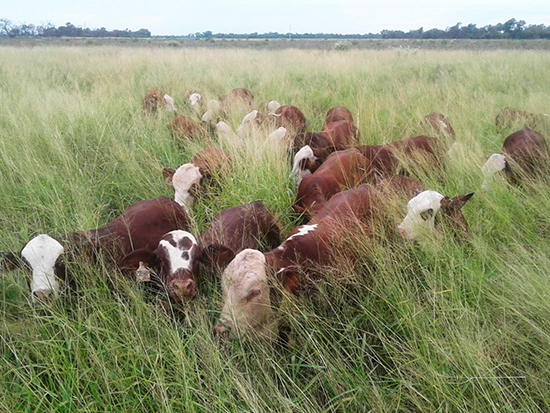


In addition to offering Braford Herd Sires and elite animals, Pilagá is currently developing a beef production project in Santiago del Estero. The company is undertaking this ambitious project of added value and validation of its genetics at Establecimiento Las Palmitas, in Campo Gallo, in the northeast of Santiago del Estero.
As elsewhere in the NOA, fodder production in Las Palmitas is determined by rainfall with great seasonality and inter-annual variation. This reality implies working with important safety margins in terms of fodder. Therefore, the company bases its nutrition strategy on rearing cattle on mega thermal pastures (Gatton Panic) and maintaining fodder stocks, with strategic supplementation during the winter season. As regards stocks, Gatton Panic is chopped and ensiled (at the time of maximum volume) to ensure the availability of effective fiber for use in dry years (quantity is sought instead of quality). The estimate is made based on the amount that the farm is going to use in one year: the premise is to always have silage for one year in stock. Gatton Panic has been implanted in the lands of Las Palmitas and other fields belonging to the group for over 10 years; thus, the strategy of producing stock (silage) from the chopping of fodder has become one of the most economical and environmentally friendly ways of producing fiber.


Meanwhile, the strategic supplementation in the region will have to be mainly protein-based, with products that are typically available in the region, such as cotton seeds, soybean or sunflower expeller, among others. In the last few years, Pilagá and its business group have incorporated dried distiller's grains as livestock feed, firstly to the feedlot finishing diet and later as a supplement for free-range rearing. This byproduct of corn distillery is valued for providing a source of crude protein and energy, and because of its excellent palatability.
The adjustments to the model allow for minimizing the use of strategic supplementation only to the winter months or when appropriate—to sustain daily weight gain—, and to the feedlot finishing stage. The model’s central goal is to achieve the greatest weight gain on pasture without neglecting time—hence the focus on daily gain throughout the rearing stage.

Calves generally arrive on the farm weighting approximately 160 kg per head. They are allocated in pens and they are provided with high-fiber and high-protein diets in order to balance their body and health conditions. Only in this way calves will be able to efficiently gain weight by grazing on pasture, taking advantage of Gatton Panic, and with the implementation of strategic supplementations aimed at maintaining an average daily weight gain of 500-600 g.
The rearing stage lasts 6 to 8 months depending on calves' weight on arrival and on the end target market (consumption or export), and after this calves are allocated in finishing feedlots. In this scheme, the use of feedlots is a key factor in determining the final price of the product. The goal is to finish the product in due time and manner, taking advantage of the cheap kilos gained on grazing. That is to say, feedlot finishing is considered as a necessary supplement which provides the finishing touch to the rearing stage, acting as the final link of the northern beef chain. As a result, slaughtered steers are not older than 18-20 months (depending on the target market: internal consumption, export or 481 beef quota).